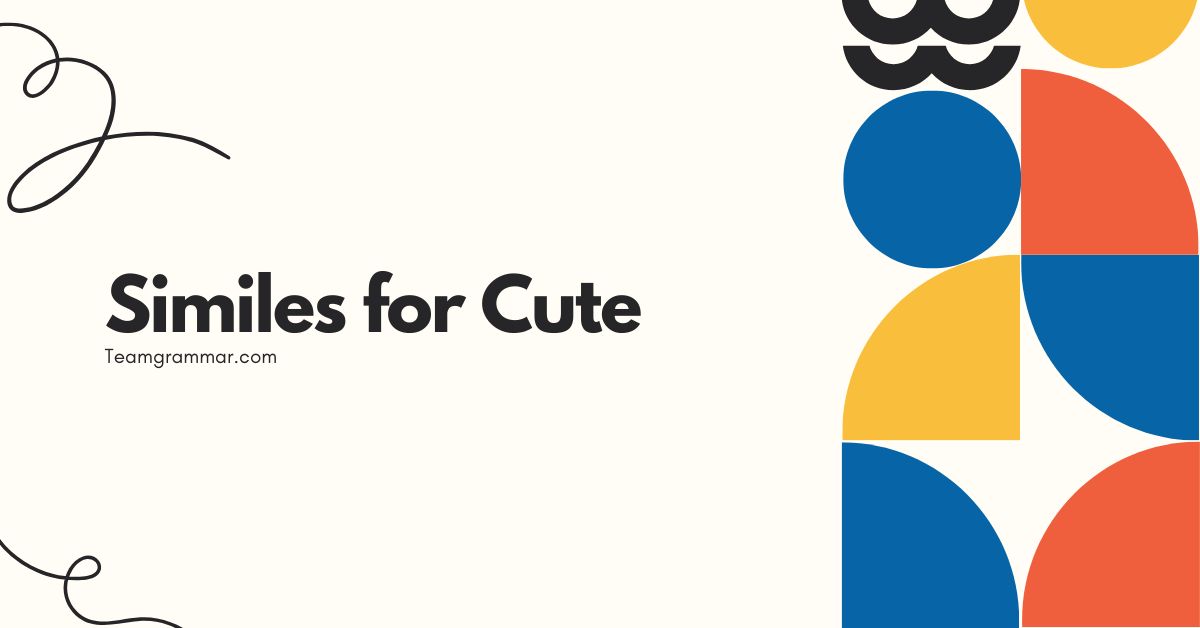31 Similes for Cute: A Comprehensive Guide to Expressing Adorableness
Understanding and using similes effectively is a vital part of mastering the English language, especially when you want to express nuanced emotions and vivid descriptions. When it comes to describing something as “cute,” simple adjectives often fall short.
Similes provide a way to elevate your language, injecting creativity and depth into your expressions. This guide is designed to help you explore the world of similes for “cute,” providing you with the knowledge and practice needed to use them confidently.
Whether you’re a student, writer, or simply someone looking to enhance your communication skills, this article will equip you with the tools to paint adorable pictures with your words.
Table of Contents
- Definition of Simile
- Structural Breakdown of Similes
- Categories of Similes for Cute
- Examples of Similes for Cute
- Usage Rules for Similes
- Common Mistakes with Similes
- Practice Exercises
- Advanced Topics in Similes
- FAQ: Frequently Asked Questions
- Conclusion
Definition of Simile
A simile is a figure of speech that directly compares two different things using the words “like” or “as.” The purpose of a simile is to create a vivid image in the reader’s mind by drawing a parallel between something familiar and something less so. Similes enhance descriptive writing and allow for a more impactful expression of emotions and qualities.
In essence, a simile functions as a bridge, connecting two seemingly unrelated concepts to highlight a shared characteristic. This comparison helps the audience understand or appreciate the subject in a new and more insightful way.
Unlike metaphors, which state that one thingisanother, similes acknowledge the difference while emphasizing the similarity.
The function of a simile extends beyond mere description. It can also evoke specific emotions, create a particular mood, or add humor to writing.
By carefully selecting the objects being compared, a writer can subtly influence the reader’s perception of the subject. For example, comparing a baby’s laugh to the tinkling of bells creates a sense of lightness and joy.
Classification of Similes
Similes can be classified based on the type of comparison they make. Some focus on physical attributes, while others highlight emotional or behavioral similarities.
Understanding these classifications can help you create more precise and effective similes.
- Physical Similes: These compare physical characteristics such as appearance, size, or texture. Example: As small as a button.
- Emotional Similes: These compare emotional states or feelings. Example: As happy as a clam.
- Behavioral Similes: These compare actions or behaviors. Example: As playful as a kitten.
- Abstract Similes: These compare abstract concepts or ideas. Example: As clear as crystal.
Context of Similes
The context in which a simile is used is crucial to its effectiveness. A simile that works well in one situation may be inappropriate in another.
Consider the audience, the tone of the writing, and the overall message you are trying to convey.
For instance, a highly formal setting might call for more sophisticated and subtle similes, while a casual conversation might allow for more lighthearted and whimsical comparisons. Always tailor your similes to fit the specific context to ensure they resonate with your audience and achieve the desired effect.
Structural Breakdown of Similes
The basic structure of a simile is quite simple, but understanding its components can help you construct more creative and impactful comparisons. A simile typically consists of three key elements: the subject, the comparison word (like or as), and the object of comparison.
Thesubjectis the thing being described. Thecomparison word(“like” or “as”) acts as the bridge between the subject and the object of comparison.
Theobject of comparisonis the thing that the subject is being compared to. Together, these elements create a clear and concise comparison.
Here’s the general formula:
Subject + Comparison Word (like/as) + Object of Comparison
Let’s break this down with examples:
- Subject: The baby
- Comparison Word: as
- Object of Comparison: a button
- Simile: The baby is as cute as a button.
Variations in sentence structure can also be used to create similes. For example, you can start the sentence with the comparison word or embed the simile within a larger sentence.
- Starting with “As”: As cute as a puppy, the little girl giggled.
- Embedded Simile: Her smile, like sunshine on a cloudy day, was incredibly cute.
Understanding these structural variations allows you to create more dynamic and engaging similes that fit seamlessly into your writing.
Categories of Similes for Cute
When describing something as “cute,” there are various angles you can take. You might focus on its small size, its innocent nature, or its endearing behavior.
By categorizing similes based on these different aspects, you can choose the most appropriate comparison for your specific needs.
Similes Emphasizing Small Size
These similes highlight the diminutive size of something cute, emphasizing its tininess and vulnerability.
- As small as a button
- As tiny as a mouse
- As little as a peanut
- As miniature as a doll
- As petite as a flower petal
Similes Emphasizing Innocence
These similes focus on the pure and untainted nature of something cute, evoking feelings of tenderness and protectiveness.
- As innocent as a lamb
- As pure as the driven snow
- As angelic as a cherub
- As naive as a newborn
- As gentle as a feather
Similes Emphasizing Endearing Behavior
These similes highlight the charming and lovable actions of something cute, making it even more appealing.
- As playful as a kitten
- As cuddly as a teddy bear
- As curious as a puppy
- As clumsy as a baby deer
- As sweet as honey
Similes Emphasizing Appearance
These similes focus on the visual aspects that make something cute, such as its roundness, softness, or bright colors.
- As round as a dumpling
- As soft as a cloud
- As bright as a daisy
- As fluffy as a cotton ball
- As sparkly as a gem
Examples of Similes for Cute
To truly master the art of using similes for “cute,” it’s essential to explore a wide range of examples. The following tables provide numerous similes categorized by different aspects of cuteness, offering you a comprehensive resource for your writing and communication needs.
The first table focuses on similes that describe the overall feeling of cuteness, often associated with babies and small animals. These similes evoke a sense of warmth, tenderness, and delight.
They are useful for capturing the immediate emotional response to something adorable.
| Simile | Explanation |
|---|---|
| As cute as a button | Classic simile emphasizing smallness and charm. |
| As sweet as pie | Highlights the pleasant and delightful nature. |
| As adorable as a puppy | Uses a universally loved animal to convey cuteness. |
| As charming as a cherub | Associates with angelic and innocent qualities. |
| As precious as a pearl | Emphasizes rarity and value. |
| As delightful as a dream | Conveys a sense of joy and pleasure. |
| As lovely as a rosebud | Compares to a beautiful and delicate flower. |
| As winsome as a kitten | Highlights the appealing and attractive qualities. |
| As fetching as a fawn | Suggests an attractive and captivating quality. |
| As darling as a daisy | Uses a simple and cheerful flower to convey cuteness. |
| As precious as gold | Indicates something is highly valued and cherished. |
| As sweet as sugar | Emphasizes sweetness and pleasantness. |
| As cute as a bug in a rug | A playful and endearing expression of cuteness. |
| As lovable as a teddy bear | Compares to a comforting and beloved toy. |
| As pretty as a picture | Highlights visual attractiveness and aesthetic appeal. |
| As pleasant as a summer breeze | Conveys a sense of lightness and joy. |
| As captivating as a sunrise | Emphasizes beauty and enchantment. |
| As enchanting as a fairy tale | Suggests a magical and delightful quality. |
| As heartwarming as a hug | Evokes feelings of comfort and affection. |
| As appealing as a bowl of candy | Uses a tempting treat to convey attractiveness. |
| As endearing as a smile | Highlights the ability to inspire affection. |
| As gentle as a lamb | Implies tenderness and mildness. |
| As innocent as a dove | Conveys purity and harmlessness. |
| As refreshing as a spring rain | Indicates a revitalizing and pleasant quality. |
| As stunning as a rainbow | Emphasizes beauty and vibrancy. |
This table presents similes that focus on the physical appearance of something cute. These similes often involve comparisons to soft, round, or delicate objects.
They are particularly useful when describing the visual appeal of babies, animals, or even inanimate objects.
| Simile | Explanation |
|---|---|
| As round as a button | Highlights the circular shape and small size. |
| As soft as a cloud | Emphasizes the gentle and plush texture. |
| As fluffy as a cotton ball | Conveys a light and airy appearance. |
| As bright as a daisy | Highlights the cheerful and vibrant colors. |
| As delicate as a flower petal | Emphasizes fragility and beauty. |
| As smooth as silk | Conveys a luxurious and gentle texture. |
| As shiny as a new penny | Highlights the clean and polished appearance. |
| As plump as a berry | Emphasizes roundness and fullness. |
| As rosy as a cherub’s cheek | Highlights the healthy and vibrant color. |
| As tiny as a dewdrop | Emphasizes smallness and delicacy. |
| As radiant as the sun | Conveys brightness and warmth. |
| As luminous as a star | Highlights the shining and glowing quality. |
| As vibrant as a hummingbird | Emphasizes energy and colorfulness. |
| As petite as a hummingbird | Highlights small size and daintiness. |
| As precious as a porcelain doll | Emphasizes fragility and beauty. |
| As sparkling as a diamond | Conveys brilliance and allure. |
| As gleaming as polished silver | Highlights the clean and reflective surface. |
| As colorful as a butterfly | Emphasizes vibrancy and variety. |
| As neat as a pin | Highlights orderliness and tidiness. |
| As elegant as a swan | Conveys gracefulness and beauty. |
| As picturesque as a postcard | Emphasizes visual appeal and charm. |
| As refined as crystal | Highlights elegance and purity. |
| As well-formed as a sculpture | Conveys precision and beauty. |
| As pristine as fresh snow | Highlights purity and cleanness. |
| As immaculate as a pearl | Emphasizes flawlessness and beauty. |
The final table focuses on similes that describe the behavior or actions of something cute. These similes often involve comparisons to playful animals, innocent beings, or comforting objects.
They are particularly useful when describing the endearing actions of children, pets, or even fictional characters.
| Simile | Explanation |
|---|---|
| As playful as a kitten | Highlights the energetic and joyful nature. |
| As cuddly as a teddy bear | Emphasizes the desire for comfort and affection. |
| As curious as a puppy | Highlights the inquisitive and exploratory nature. |
| As clumsy as a baby deer | Conveys a sense of awkwardness and innocence. |
| As sweet as honey | Emphasizes the pleasant and agreeable behavior. |
| As gentle as a lamb | Conveys a sense of mildness and tenderness. |
| As innocent as a dove | Highlights the pure and harmless nature. |
| As lively as a firefly | Emphasizes energy and vibrancy. |
| As animated as a cartoon character | Highlights expressiveness and liveliness. |
| As spirited as a pony | Conveys enthusiasm and energy. |
| As affectionate as a golden retriever | Emphasizes loving and caring behavior. |
| As friendly as a dolphin | Highlights sociability and warmth. |
| As cheery as a robin | Conveys happiness and optimism. |
| As bubbly as champagne | Emphasizes enthusiasm and effervescence. |
| As sunny as a sunflower | Highlights cheerfulness and brightness. |
| As serene as a sleeping angel | Conveys peace and tranquility. |
| As graceful as a ballerina | Emphasizes elegance and poise. |
| As sprightly as a fairy | Highlights energy and playfulness. |
| As amiable as a golden retriever | Emphasizes friendliness and warmth. |
| As well-behaved as a trained puppy | Conveys obedience and politeness. |
| As engaging as a good story | Highlights the ability to captivate and hold attention. |
| As pleasant as a gentle breeze | Conveys calmness and mildness. |
| As amusing as a clown | Emphasizes humor and entertainment. |
| As charming as a prince | Highlights elegance and grace. |
| As delightful as a child’s laughter | Emphasizes joy and innocence. |
Usage Rules for Similes
Using similes effectively requires adherence to certain rules and guidelines. These rules ensure that your similes are clear, impactful, and appropriate for the context in which they are used.
- Clarity: The comparison should be clear and easily understood. Avoid obscure or overly complex comparisons that might confuse the reader.
- Relevance: The object of comparison should share a relevant characteristic with the subject. The similarity should be meaningful and contribute to the overall description.
- Originality: While common similes can be effective, strive for originality to make your writing more engaging and memorable. Think outside the box and explore unique comparisons.
- Appropriateness: The simile should be appropriate for the tone and context of the writing. Avoid using similes that are offensive, insensitive, or out of place.
- Conciseness: Keep your similes concise and to the point. Avoid adding unnecessary words or phrases that might dilute the impact of the comparison.
Exceptions:Sometimes, breaking these rules can be effective for stylistic purposes. For example, using an unexpected or absurd simile can create humor or emphasize a particular point.
However, these exceptions should be used sparingly and with careful consideration.
Common Mistakes with Similes
Even experienced writers can make mistakes when using similes. Being aware of these common errors can help you avoid them and improve the quality of your writing.
- Clichés: Overusing common similes can make your writing sound unoriginal and predictable. Example: As cute as a button (cliché) vs. As cute as a freshly hatched chick (more original).
- Mixed Metaphors and Similes: Confusing metaphors and similes can create illogical and confusing comparisons. Example: Incorrect: Her voice was like a velvet hammer. (Mixing simile and metaphor). Correct: Her voice was like velvet. (Simile).
- Inaccurate Comparisons: Choosing objects of comparison that do not share a relevant characteristic with the subject can weaken the simile. Example: Incorrect: The baby was as cute as a rock. (Rocks are not typically associated with cuteness). Correct: The baby was as cute as a fluffy bunny.
- Overly Complex Similes: Using overly complex or convoluted similes can confuse the reader and detract from the overall message. Example: Incorrect: The puppy’s nose was as cute as the intricate design on a Byzantine mosaic. Correct: The puppy’s nose was as cute as a button.
The table below provides examples of common mistakes and their corrected versions.
| Incorrect Simile | Corrected Simile | Explanation |
|---|---|---|
| As cute as a button (cliché) | As cute as a newborn fawn | Avoids a common cliché by using a more original comparison. |
| Her smile was a ray of sunshine, like a melody. | Her smile was like a ray of sunshine. | Avoids mixing a metaphor (ray of sunshine) with a simile. |
| The kitten was as cute as a brick wall. | The kitten was as cute as a ball of yarn. | Uses a more relevant and appropriate comparison. |
| The baby was as cute as the philosophical implications of existentialism. | The baby was as cute as a little dumpling. | Simplifies the simile for clarity and impact. |
Practice Exercises
To solidify your understanding of similes for “cute,” try these practice exercises. Each exercise challenges you to create or identify effective similes.
Exercise 1: Fill in the Blanks
Complete the following sentences by adding a simile that describes the subject as “cute.”
| Question | Answer |
|---|---|
| 1. The puppy was as ______ as ______. | 1. The puppy was as playful as a kitten. |
| 2. The baby’s smile was as ______ as ______. | 2. The baby’s smile was as sweet as honey. |
| 3. Her dress was as ______ as ______. | 3. Her dress was as delicate as a flower petal. |
| 4. The hamster was as ______ as ______. | 4. The hamster was as tiny as a mouse. |
| 5. The little girl was as ______ as ______. | 5. The little girl was as charming as a cherub. |
| 6. The newborn lamb was as ______ as ______. | 6. The newborn lamb was as gentle as a feather. |
| 7. The child’s eyes were as ______ as ______. | 7. The child’s eyes were as bright as stars. |
| 8. The stuffed animal was as ______ as ______. | 8. The stuffed animal was as cuddly as a teddy bear. |
| 9. The cake was as ______ as ______. | 9. The cake was as pretty as a picture. |
| 10. The small bird was as ______ as ______. | 10. The small bird was as petite as a hummingbird. |
Exercise 2: Identify the Simile
Identify the simile in each of the following sentences.
| Question | Answer |
|---|---|
| 1. Her cheeks were as rosy as apples. | 1. as rosy as apples |
| 2. The kitten, playful and energetic, bounced around the room. | 2. (No simile) |
| 3. The puppy was like a furry little tornado. | 3. like a furry little tornado |
| 4. The baby’s laughter filled the room with joy. | 4. (No simile) |
| 5. The flowers were as vibrant as a painter’s palette. | 5. as vibrant as a painter’s palette |
| 6. The child was as quiet as a mouse. | 6. as quiet as a mouse |
| 7. The snow fell softly on the ground. | 7. (No simile) |
| 8. The stars twinkled in the night sky like diamonds. | 8. like diamonds |
| 9. The forest was dark and mysterious. | 9. (No simile) |
| 10. Her voice was as smooth as silk. | 10. as smooth as silk |
Exercise 3: Create Your Own Similes
Write a simile for each of the following subjects, describing them as “cute.”
| Subject | Your Simile |
|---|---|
| A baby bunny | A baby bunny is as cute as a cotton ball with ears. |
| A newborn chick | A newborn chick is as cute as a fluffy yellow pom-pom. |
| A kitten’s paws | A kitten’s paws are as cute as tiny velvet cushions. |
| A toddler’s giggle | A toddler’s giggle is as cute as the tinkling of tiny bells. |
| A sleeping puppy | A sleeping puppy is as cute as a small, furry angel. |
| A hamster’s nose | A hamster’s nose is as cute as a tiny pink bead. |
| A baby’s toes | A baby’s toes are as cute as little pink candies. |
| A puppy’s bark | A puppy’s bark is as cute as a small squeaky toy. |
| A child’s drawing | A child’s drawing is as cute as a burst of colorful imagination. |
| A baby’s yawn | A baby’s yawn is as cute as a tiny, silent roar. |
Advanced Topics in Similes
For advanced learners, exploring more complex aspects of similes can enhance your writing and analytical skills. This includes understanding the cultural context of similes, analyzing their rhetorical effect, and experimenting with unconventional comparisons.
- Cultural Context: Similes can be deeply rooted in cultural references and shared experiences. Understanding these cultural nuances is crucial for using similes effectively and avoiding misunderstandings. For example, a simile that references a specific animal or plant might not resonate with readers from a different cultural background.
- Rhetorical Effect: Analyzing the rhetorical effect of similes involves examining how they persuade, inform, or entertain the reader. Consider the emotional impact of the simile, its ability to create vivid imagery, and its contribution to the overall message.
- Unconventional Comparisons: Experimenting with unconventional comparisons can lead to unique and memorable similes. This involves challenging traditional associations and exploring unexpected similarities between seemingly unrelated objects or concepts. However, it’s important to ensure that the comparison remains clear and relevant.
FAQ: Frequently Asked Questions
- What is the difference between a simile and a metaphor?
A simile compares two things using “like” or “as,” while a metaphor states that one thing is another. Similes acknowledge the difference between the two things being compared, while metaphors create a direct equivalence.
- Can a simile be a cliché?
Yes, a simile can become a cliché if it’s overused and lacks originality. Strive to use fresh and creative comparisons to avoid clichés.
- How can I make my similes more original?
Think outside the box and explore unexpected similarities between different things. Try to avoid common comparisons and focus on creating unique and memorable images.
- What if I can’t think of a good simile?
Start by brainstorming a list of characteristics that you want to emphasize. Then, think of objects or concepts that share those characteristics. Don’t be afraid to experiment and try different combinations.
- Is it okay to use humor in similes?
Yes, humor can be a very effective tool in similes. However, make sure that the humor is appropriate for the context and audience.
- How important is context when using similes?
Context is crucial. A simile that works well in one situation might be inappropriate in another. Consider the audience, tone, and overall message of your writing.
- What are some common words besides “like” and “as” that can be used in similes?
While “like” and “as” are the most common, other words that imply comparison, such as “resembles,” “similar to,” or “comparable to,” can also be used to create simile-like effects.
- How can I improve my simile writing skills?
Practice regularly, read widely, and pay attention to the similes used by other writers. Experiment with different comparisons and ask for feedback on your writing.
- Are there cultural differences in understanding similes?
Yes, similes can be deeply rooted in cultural references and shared experiences. What might be a clear and evocative simile in one culture could be confusing or meaningless in another. Awareness of these cultural nuances is crucial for effective communication.
- Can a simile be too complex?
Yes, if a simile is overly convoluted or relies on obscure references, it can confuse the reader and diminish its impact. Simplicity and clarity are often key to a successful simile.
Conclusion
Mastering the art of using similes for “cute” involves understanding their definition, structure, and usage rules. By exploring a wide range of examples and practicing regularly, you can enhance your writing and communication skills, adding depth and creativity to your expressions.
Remember to strive for originality, relevance, and appropriateness in your similes, and be mindful of common mistakes.
As you continue to develop your skills, consider exploring more advanced topics such as the cultural context of similes and their rhetorical effect. With consistent effort and a keen eye for detail, you can become a master of simile writing, painting vivid and adorable pictures with your words.
The key is to keep experimenting, observing, and refining your craft.
By understanding and applying the principles outlined in this guide, you’ll be well-equipped to use similes effectively and confidently, transforming your descriptions of “cute” from simple statements into delightful and memorable expressions.







